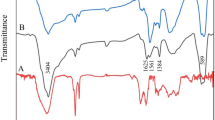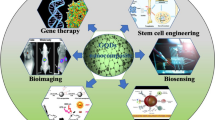Abstract
In this research work, the superparamagnetic graphene composites were produced by two parallel co-precipitation processes using the leaf extracts of Melia dubia and Prosopis juliflora. We also replaced the commercial graphite with the low-cost raw bio source, Pennisetum glaucum panicle waste for graphene oxide production. Magnetic nanoparticle with graphene oxide enhances the surface area with functionalization, high loading capacity, and good conductivity. The stability, colloidal dispersivity, particle size range, composition ratio of iron oxide to graphene oxide, and superparamagnetism were characterized by UV–visible spectrophotometer, powder X-ray diffraction (PXRD), Fourier transformation infrared spectroscopy (FT-IR), field emission scanning electron microscopy (FESEM), energy dispersion X-ray (EDX and vibrating sample magnetometer (VSM), etc. Our composite reported better biocompatibility and cytotoxicity with less than 5% hemolysis of RBCs and up to 1 µg concentration as a safer dosage from the MTT assay. Additionally, biofilm inhibition, antioxidant, and biocompatibility activities were confirmed for statistical significance with a p value (< 0.05) by two-way ANOVA balanced design method and the composite yield parameters were optimized by response surface method using central composite design. These unique properties enabled our sample to attenuate X-ray–CT imaging and MRI phantom imaging with better contrast, almost equivalent to the commercial agents. Thus, our results provide a new avenue for multimodality contrast applications and upon loading with suitable drug it may open up a new path for potential theranostic applications.













Similar content being viewed by others
Data availability
The datasets generated during and/or analyzed during the current study are available from the corresponding author upon reasonable request.
References
Z. Qiao, X. Shi, Dendrimer-based molecular imaging contrast agents. Prog. Polym. Sci. 44, 1–27 (2015)
T. Kamakshi, G.S. Sundari, H. Erothu et al., Synthesis and characterization of graphene based iron oxide (Fe3O4) nanocomposites. Rasayan J. Chem. 11(3), 1113–1119 (2018)
P.L. Hariani, M. Faizal, R. Ridwan et al., Synthesis and properties of Fe3O4 nanoparticles by co-precipitation method to removal procion dye. Int. J. Environ. Sci Develop. 4(3), 336–340 (2013)
Y. Yuan, Z. Ding, J. Qian et al., Casp3/7-instructed intracellular aggregation of Fe3O4 nanoparticles enhances T2 MR imaging of tumor apoptosis. Nano Lett. 16(4), 2686–2691 (2016)
Z. Ding, H. Sun, S. Ge et al., Furin-controlled Fe3O4 nanoparticle aggregation and 19F signal “Turn-On” for precise MR imaging of tumors. Adv. Func. Mater. 29(43), 1903860 (2019)
T.N. Narayanan, B.K. Gupta, S.A. Vithayathil et al., Hybrid 2D nanomaterials as dual-mode contrast agents in cellular imaging. Adv. Mater. 24(22), 2992–2998 (2012)
A.B. Seabra, P. Haddad, N. Duran, Biogenic synthesis of nanostructured iron compounds: applications and perspectives. IET Nanobiotechnol. 7(3), 90–99 (2013)
M. Doble, K. Rollins, A. Kumar, Green chemistry and engineering. Academic Press (2010).
Y. Wu, Y. Sun, X. Zhu et al., Lanthanide-based nanocrystals as dual-modal probes for SPECT and X-ray CT imaging. Biomaterials 35(16), 4699–4705 (2014)
R. Smith-Bindman, J. Lipson, R. Marcus et al., Radiation dose associated with common computed tomography examinations and the associated lifetime attributable risk of cancer. Arch. Intern. Med. 169(22), 2078–2086 (2009)
A.B. De González, M. Mahesh, K.P. Kim et al., Projected cancer risks from computed tomographic scans performed in the United States in 2007. Arch. Intern. Med. 169(22), 2071–2077 (2009)
S. Badrigilan, B. Shaabani, N. Gharehaghaji et al., Iron oxide/bismuth oxide nanocomposites coated by graphene quantum dots:“Three-in-one” theranostic agents for simultaneous CT/MR imaging-guided in vitro photothermal therapy. Photodiagn. Photodyn. Ther. 25, 504–514 (2019)
T. Somanathan, K. Prasad, K.K. Ostrikov et al., Graphene oxide synthesis from agro waste. Nanomaterials 5(2), 826–834 (2015)
A. Konwar, S. Kalita, J. Kotoky et al., Chitosan–iron oxide coated graphene oxide nanocomposite hydrogel: a robust and soft antimicrobial biofilm. ACS Appl. Mater. Interfaces. 8(32), 20625–20634 (2016)
A. Vinitha, Phytochemical and Pharmacological Evaluation of Pedalium Murex Linn Leaves (Doctoral dissertation, JKK Nattraja College of Pharmacy, Komarapalayam) (2017).
M.M. Wai, C.S. Khe, X.H. Yau et al., Optimization and characterization of magnetite–reduced graphene oxide nanocomposites for demulsification of crude oil in water emulsion. RSC Adv. 9(41), 24003–24014 (2019)
F. Lin, C. Li, Z. Chen, Bacteria-derived carbon dots inhibit biofilm formation of Escherichia coli without affecting cell growth. Front. Microbiol. 9, 259 (2018)
M. Myekhlai, T. Lee, S. Lee et al., Synthesis and characterization of the graphene-Fe3O4 hybrid composite. J. Nanosci. Nanotechnol. 15(3), 2047–2051 (2015)
S.T. Navale, G.D. Khuspe, M.A. Chougule et al., Synthesis and characterization of hybrid nanocomposites of polypyrrole filled with iron oxide nanoparticles. J. Phys. Chem. Solids 75(2), 236–243 (2014)
P. Mallick, B.N. Dash, X-ray diffraction and UV-visible characterizations of α-Fe2O3 nanoparticles annealed at different temperature. Nanosci. Nanotechnol. 3(5), 130–134 (2013)
E.L. Albert, C.A. Abdullah, Y. Shiroshaki, Synthesis and characterization of graphene oxide functionalized with magnetic nanoparticle via simple emulsion method. Results in Physics. 11, 944–950 (2018)
E. Aliyari, M. Alvand, F. Shemirani, Modified surface-active ionic liquid-coated magnetic graphene oxide as a new magnetic solid phase extraction sorbent for preconcentration of trace nickel. RSC Adv. 6(69), 64193–64202 (2016)
M. Aliabadi, H. Shagholani, Synthesis of a novel biocompatible nanocomposite of graphene oxide and magnetic nanoparticles for drug delivery. Int. J. Biol. Macromol. 98, 287–291 (2017)
P. Zong, S. Wang, Y. Zhao et al., Synthesis and application of magnetic graphene/iron oxides composite for the removal of U (VI) from aqueous solutions. Chem. Eng. J. 220, 45–52 (2013)
P.L. Lee, Y.K. Chiu, Y.C. Sun et al., Synthesis of a hybrid material consisting of magnetic iron-oxide nanoparticles and carbon nanotubes as a gas adsorbent. Carbon 48(5), 1397–1404 (2010)
H. Gupta, P. Paul, N. Kumar et al., One pot synthesis of water-dispersible dehydroascorbic acid coated Fe3O4 nanoparticles under atmospheric air: blood cell compatibility and enhanced magnetic resonance imaging. J. Colloid Interface Sci. 430, 221–228 (2014)
J. Yan, S. Mo, J. Nie et al., Hydrothermal synthesis of monodisperse Fe3O4 nanoparticles based on modulation of tartaric acid. Colloids Surf., A 340(1–3), 109–114 (2009)
L. Feng, M. Cao, X. Ma et al., Superparamagnetic high-surface-area Fe3O4 nanoparticles as adsorbents for arsenic removal. J. Hazard. Mater. 217, 439–446 (2012)
V. Sepelak, D. Baabe, D. Mienert et al., Enhanced magnetisation in nanocrystalline high-energy milled MgFe2O4. Scripta Mater. 48(7), 961–966 (2003)
M.M. Song, H.L. Xu, J.X. Liang et al., Lactoferrin modified graphene oxide iron oxide nanocomposite for glioma-targeted drug delivery. Mater. Sci. Eng. 77, 904–911 (2017)
L. Kopanja, S. Kralj, D. Zunic et al., Core–shell superparamagnetic iron oxide nanoparticle (SPION) clusters: TEM micrograph analysis, particle design and shape analysis. Ceram. Int. 42(9), 10976–10984 (2016)
X. Liu, Q. Zhou, T.L. Maxwell et al., Scandate cathode surface characterization: Emission testing, elemental analysis and morphological evaluation. Mater. Charact. 148, 188–200 (2019)
Z. Ma, Y. Guan, H. Liu, Synthesis and characterization of micron-sized monodisperse superparamagnetic polymer particles with amino groups. J. Polym. Sci., Part A: Polym. Chem. 43(15), 3433–3439 (2005)
P. Gorria, M. Sevilla, J.A. Blanco et al., Synthesis of magnetically separable adsorbents through the incorporation of protected nickel nanoparticles in an activated carbon. Carbon 44(10), 1954–1957 (2006)
S. Chong, G. Zhang, H. Tian et al., Rapid degradation of dyes in water by magnetic Fe0/Fe3O4/graphene composites. J. Environ. Sci. 44, 148–157 (2012)
B. Konkena, S. Vasudevan, Understanding aqueous dispersibility of graphene oxide and reduced graphene oxide through p K a measurements. The journal of physical chemistry letters. 3(7), 867–872 (2012)
S. Bhattacharjee, DLS and zeta potential–what they are and what they are not? J. Control. Release 235, 337–351 (2016)
B. Ankamwar, T.C. Lai, J.H. Huang et al., Biocompatibility of Fe3O4 nanoparticles evaluated by in vitro cytotoxicity assays using normal, glia and breast cancer cells. Nanotechnology 21(7), 075102 (2010)
T. Osaka, T. Nakanishi, S. Shanmugam et al., Effect of surface charge of magnetite nanoparticles on their internalization into breast cancer and umbilical vein endothelial cells. Colloids Surf. B 71(2), 325–330 (2009)
X. Zhao, Y. Shi, T. Wang et al., Preparation of silica-magnetite nanoparticle mixed hemimicelle sorbents for extraction of several typical phenolic compounds from environmental water samples. J. Chromatogr. A 1188(2), 140–147 (2008)
G. Cheng, Y.L. Liu, Z.G. Wang et al., The GO/rGO–Fe 3 O 4 composites with good water-dispersibility and fast magnetic response for effective immobilization and enrichment of biomolecules. J. Mater. Chem. 22(41), 21998–22004 (2012)
G. Cheng, X. Yu, M.D. Zhou et al., Preparation of magnetic graphene composites with hierarchical structure for selective capture of phosphopeptides. Journal of Materials Chemistry B. 2(29), 4711–4719 (2014)
B. Zhang, Y. Li, T. Wu et al., Magnetic iron oxide/graphene oxide nanocomposites: Formation and interaction mechanism for efficient removal of methylene blue and p-tert-butylphenol from aqueous solution. Mater. Chem. Phys. 205, 240–252 (2018)
S. Paulose, R. Raghavan, B.K. George, Graphite oxide–iron oxide nanocomposites as a new class of catalyst for the thermal decomposition of ammonium perchlorate. RSC Adv. 6(51), 45977–45985 (2016)
A.I. Sherlala, A.A. Raman, M.M. Bello et al., Adsorption of arsenic using chitosan magnetic graphene oxide nanocomposite. J. Environ. Manage. 246, 547–556 (2019)
G. Chaudhary, N. utan Kaushik, Bio-prospecting of Pedalium murex L. Extract for Antifungal Activity.
W. Hu, C. Peng, W. Luo et al., Graphene-based antibacterial paper. ACS nano. 4(7), 4317–4323 (2010)
Y. Tu, M. Lv, P. Xiu et al., Destructive extraction of phospholipids from Escherichia coli membranes by graphene nanosheets. Nat. Nanotechnol. 8(8), 594–601 (2013)
Y. Qiu, Z. Wang, A.C. Owens et al., Antioxidant chemistry of graphene-based materials and its role in oxidation protection technology. Nanoscale 6(20), 11744–11755 (2014)
S. Kalita, B. Devi, R. Kandimalla et al., Chloramphenicol encapsulated in poly-ε-caprolactone–pluronic composite: nanoparticles for treatment of MRSA-infected burn wounds. Int. J. Nanomed. 10, 2971 (2015)
S. Sivalingam, A. Kunhilintakath, P. Nagamony et al., Fabrication, toxicity and biocompatibility of Sesamum indicum infused graphene oxide nanofiber-a novel green composite method. Appl. Nanosci. 11(2), 679–686 (2021)
Acknowledgements
The authors would like to thank CSIR-Central Leather Research Institute, Adyar, Chennai, and Indian Institute of Technology–Madras, Chennai, for supporting the characterisation analysis performed in this study. Our sincere Thanks to Dr. P. Suresh, Assistant Professor, St. Joseph’s college of Engineering and Mr. A. Nagendran, Eswari Diagnostic Centre, Chennai, for their continuous support in interpreting the characterisation results.
Author information
Authors and Affiliations
Corresponding author
Ethics declarations
Funding sources
This research paper did not receive any specific grant from funding agencies in the public, commercial, or not-for-profit sectors.
Compliance with ethical standards
All the authors state that there is no conflict of interest.
Additional information
Publisher's Note
Springer Nature remains neutral with regard to jurisdictional claims in published maps and institutional affiliations.
Supplementary Information
Below is the link to the electronic supplementary material.
Rights and permissions
Springer Nature or its licensor (e.g. a society or other partner) holds exclusive rights to this article under a publishing agreement with the author(s) or other rightsholder(s); author self-archiving of the accepted manuscript version of this article is solely governed by the terms of such publishing agreement and applicable law.
About this article
Cite this article
Preethy, K.R., Ganesan, P. & Chamundeeswari, M. Multimodality: phantom imaging for superparamagnetic graphene composites using green technology for theranostic nanosystems. Appl. Phys. A 129, 73 (2023). https://doi.org/10.1007/s00339-022-06327-w
Received:
Accepted:
Published:
DOI: https://doi.org/10.1007/s00339-022-06327-w




